My least favourite thing about riding is punctures, with border crossings taking a very close second. Both nuisances result in an unwelcome pause and wasted time, which I hate more than anything. Border crossings can theoretically be avoided, but punctured tubes are irregularly reoccurring annoyances for the fearless adventurist. With that in mind during the preparations for Prometheus 19, I decided to run the expedition on mousses.
Nobody uses mousses on expeditions
Mousses completely remove the risk of punctures, but also yield other benefits. They give constant amazing traction and a less bouncy feel compared to tubes. Another plus is that there is no need to carry tubes, tyre irons, a pump etc. in the tool kit, reducing weight significantly. However, there are drawbacks too, as mousses are expensive, and you’re stuck with a single pressure setting for every section of the route. Furthermore, mousses can fail without warning if run carelessly. Admittedly I was a little apprehensive to commit to the mousses, but the benefits seemed to outweigh the risks. Running an expedition on mousses was a learning experience and it did not go entirely smoothly.
Lubrication kills friction
The greatest enemy of mousses is friction, as it generates heat and abrasion, which both damage the mousse. Friction between the tyre and the mousse is generated by the plastic deformation of the tyre under the load of the bike and rider. To reduce friction, mousses are installed with a silicone based lubricant, but it does not last forever inside the tyre. You could just keep running the mousses and replace them with tubes when they fail, but that would be very expensive and require carrying everything necessary for riding with tubes. Since I usually gravitate towards a lighter gear configuration, I popped the mousses every 3 000 km or so, to inspect and lube them. My 21” Michelin BIB front mousse now has 10 000 km on it after three lubes from installation. In all service breaks the mousses were still in decent shape in terms of lubrication, so I will stick to the 3 000 km lube interval in future expeditions.
Speed is heat
Riding speed is proportional to the thermal load induced by friction on the mousse. From the tyre’s perspective, it has a hot spot rotating around its outer sphere during riding. The faster the riding speed, the more passes around the tyre the hot spot makes per minute i.e. more speed equals more heat. The good thing is that on off road expeditions speed is usually pretty low, with the exception of transits on tarmac. To keep the thermal load manageable, we kept cruising speed on transit below 90 kmh (55 mph). During off road sections we were up to 140 kmh (85 mph), but as they were mostly short lived sections, they did not seem to have any effect on the mousses. I guess the greatest risk is high speed in high doses.
Light is right
As mentioned above, friction between tyre and the mousse is generated by the plastic deformation of the tyre under load. So obviously the higher the load, the more deformation and consequently more friction. The rally guys such as Lyndon Poskitt and Ionut Florea successfully run mousses on their 690/701 rally bikes, but I dare say that’s probably the heavier end of the scale of reasonable use. I have the feeling that mousses are mostly practical during off road expeditions on light single cylinder bikes. Frankly, I have zero experience in multi cylinder adventure bikes, but judging solely by their mass, I find it hard to see how a mousse would be able to provide adequate support under the load. If anyone has any experience in this, I’m all ears.
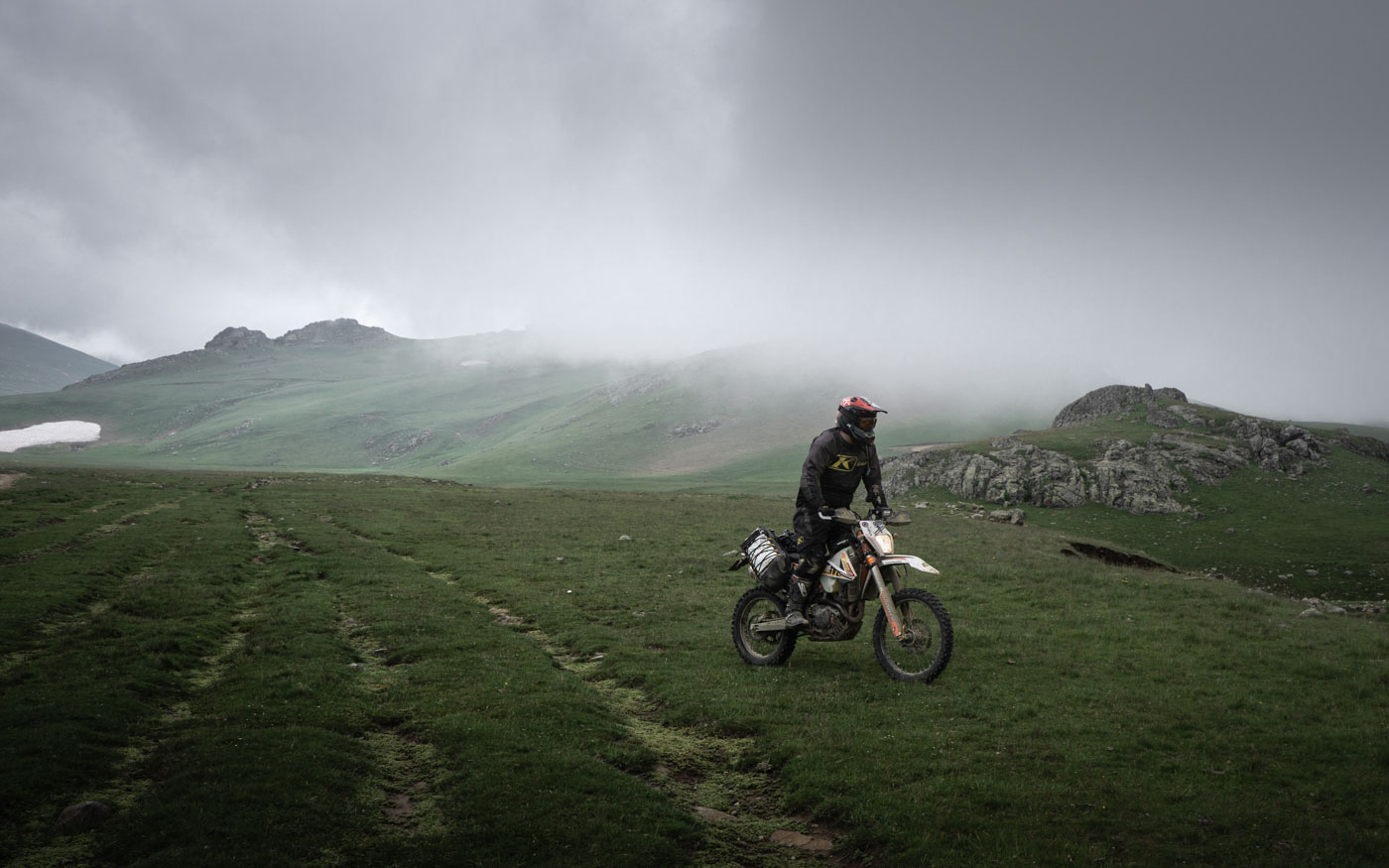
The perfect fit
A final consideration for the health of the mousse is correct tyre size. In the front I ran a Michelin M15 BIB Mousse for 21” 90/90 and 80/100 tyres. It was originally inside a 21” Michelin AC10 80/100, then a Michelin Starcross 80/100. The mousse was fine throughout the 10 000 km. In the rear I ran a Michelin M18 Enduro BIB Mousse for 18” 120/90 tyres, initially inside an 18” Michelin AC 10 120/90 and later inside a Metzeler Six Days Extreme 140/80. When we stopped to inspect and lube the mousses after 1300 km from the tyre change, the mousse had started to split on the inside ring. As the mousse had been in pristine condition just 1300 km earlier, and the damage was on the inside ring and not the side walls, I believe the damage was due to the lack of support from the side walls of the wider tyre I.e. it allowed for the mousse to be overly squashed vertically. The traction was amazing though. Either way, the damaged Michelin mousse was replaced by a Metzeler E-18H1 – Medium Enduro mousse for 18” 140/80 tyres. It was in pristine condition during inspection and lubing 3 000 km later and has now 4 300 km of use.
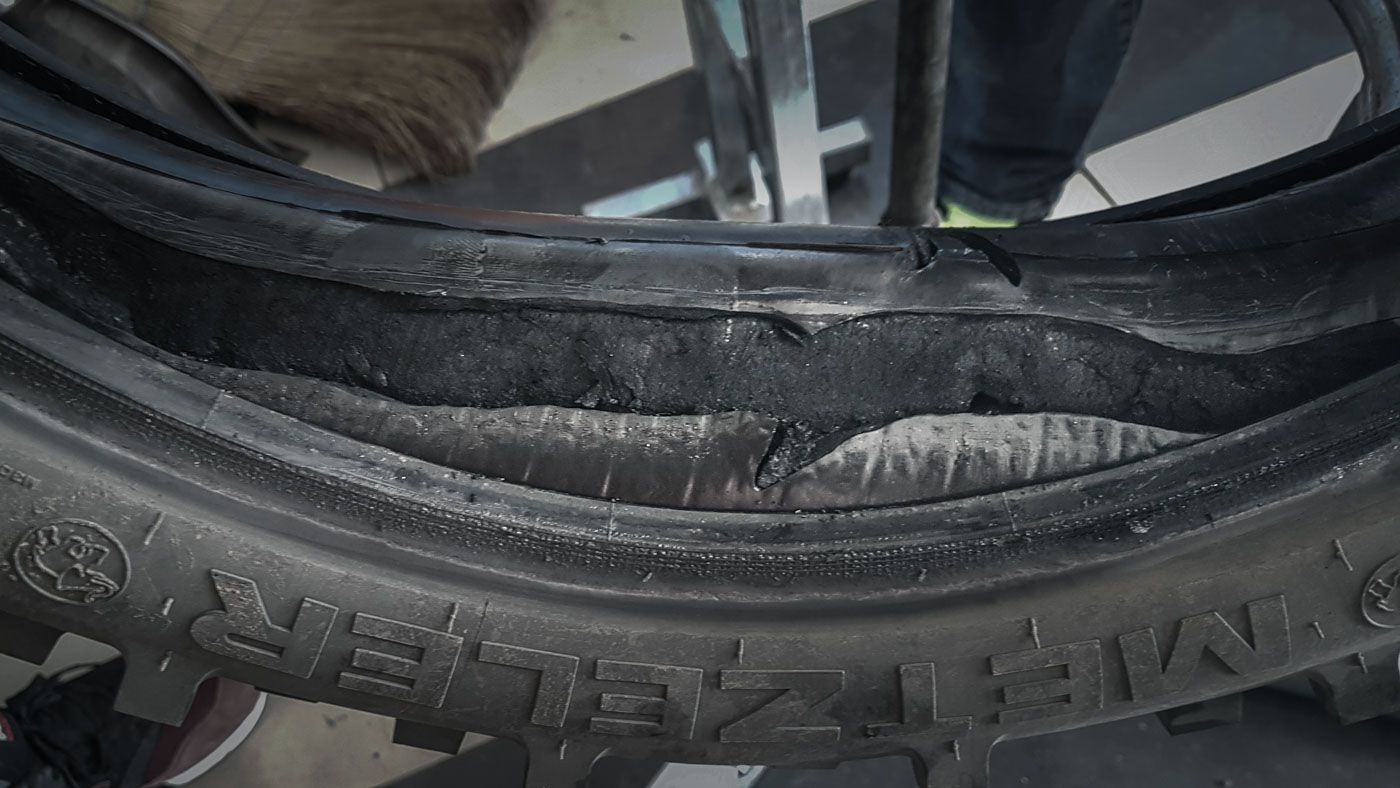
Heavy tools
Changing mousses is a ten minute job if you have the right tools; a proper mousse changer and five good tyre levers. I have the Rabaconda “3-minute mousse changer” and KTM PowerParts tyre levers. To be honest, the Rabaconda for me was more of a “two hours of frustration, swearing and sweating bullets” mousse changer initially, but once the correct technique is dialed in, it can be done in three minutes. Either way, I can’t imagine trying to lube the mousses without tyre changer, so finding a workshop with the correct tools is essential during expeditions.
The verdict
The mousses were a big win, and I would not go back to tubes lightly. It can be argued that more time, and definitely money, go into dealing with the mousses, as opposed to fixing the odd punctured tube. But the fact is that expeditions are chaotic by nature, and any small amount of added control is welcome. Lubing a mousse inside a workshop is much preferable to fixing a flat in rain, while exhausted, hungry and cold. The battle will be there either way, but dictating the field is crucial.
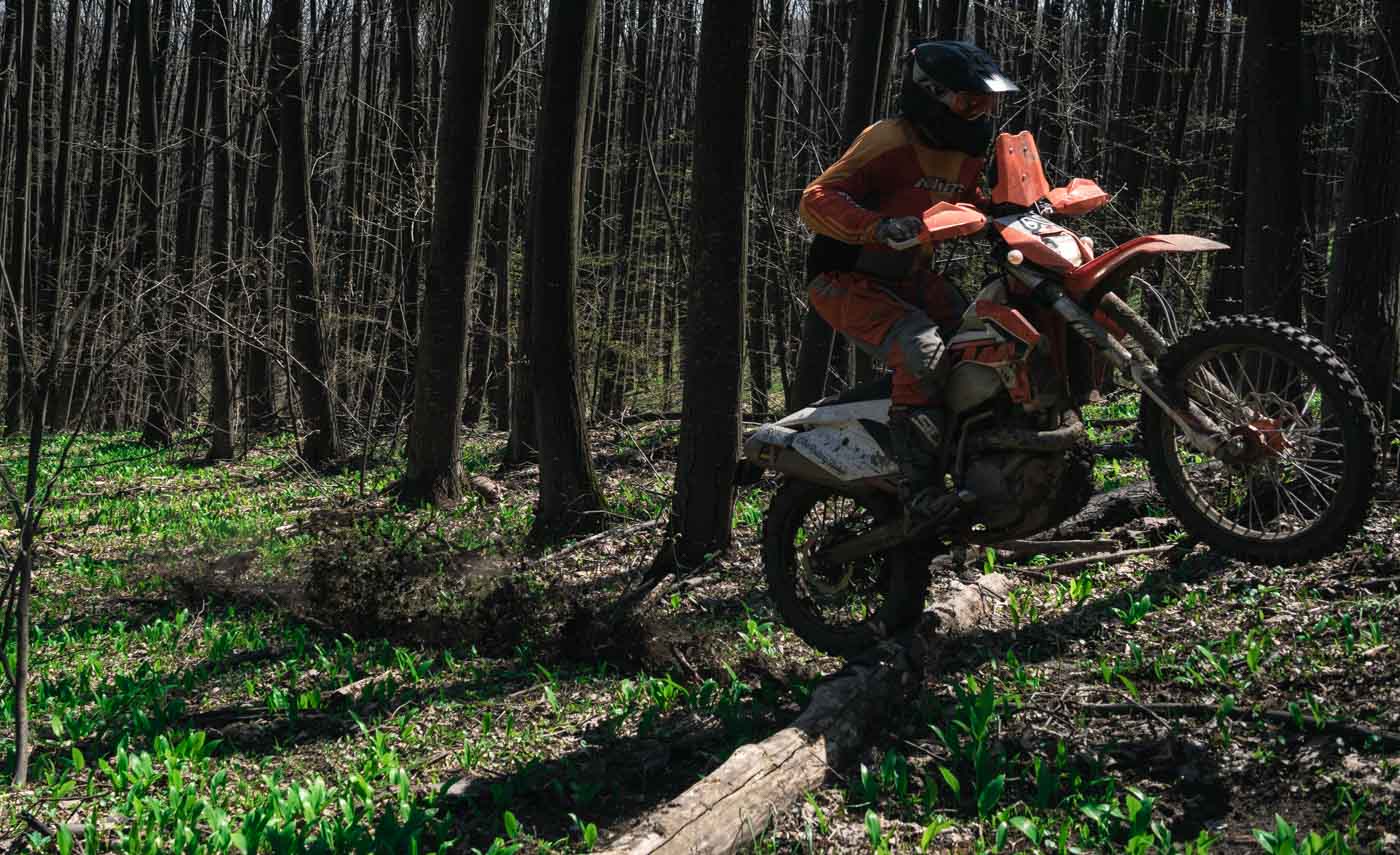
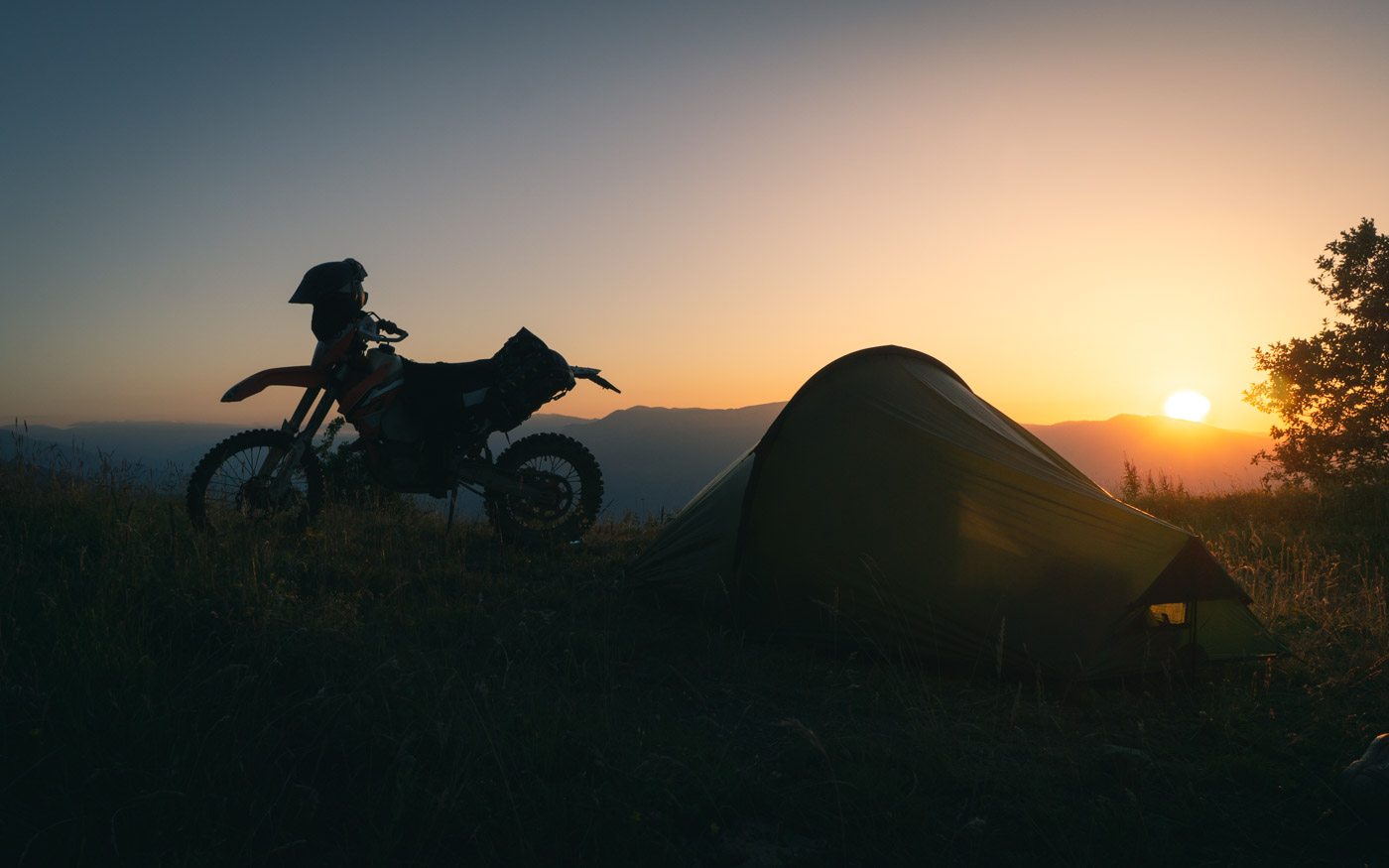
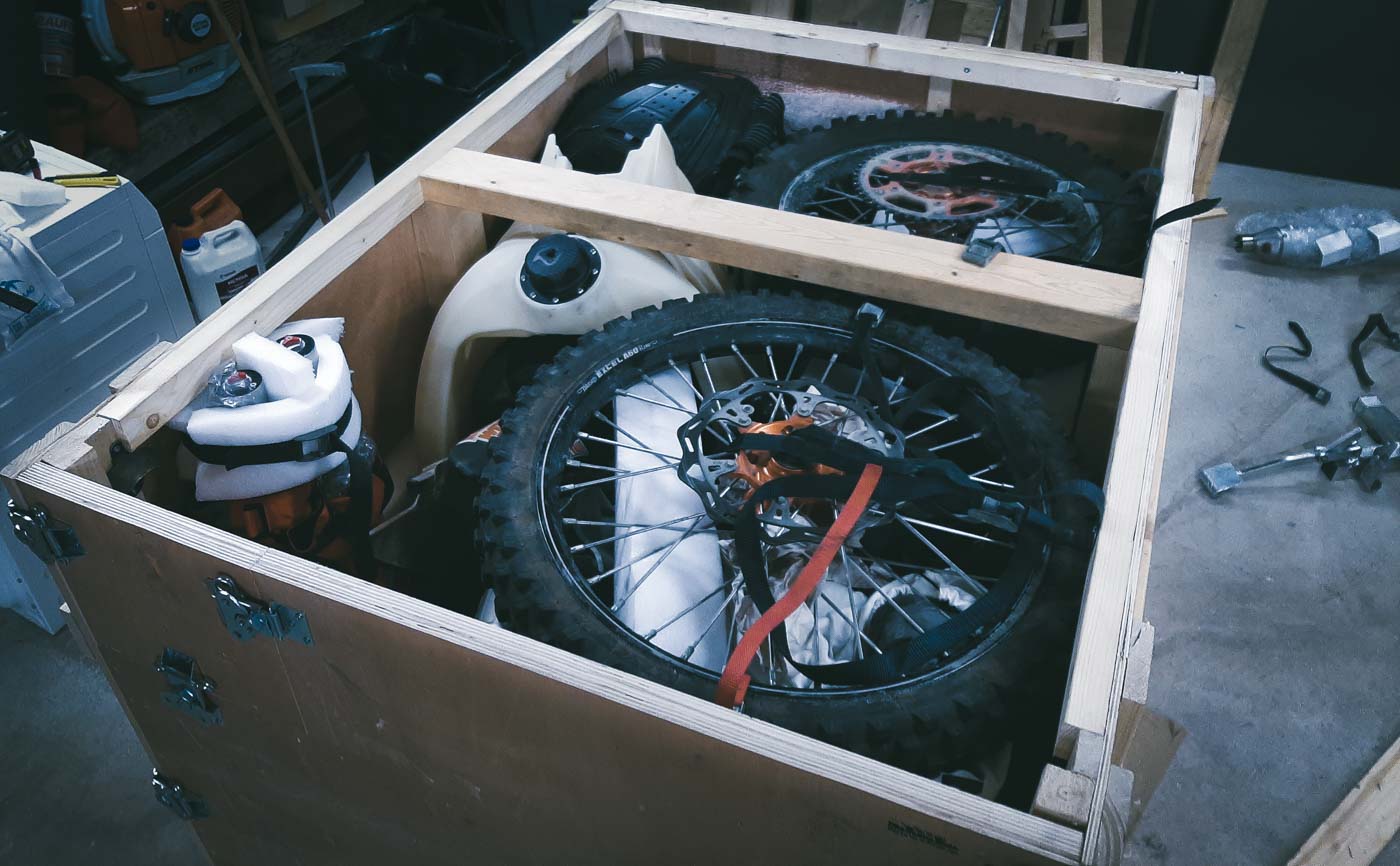
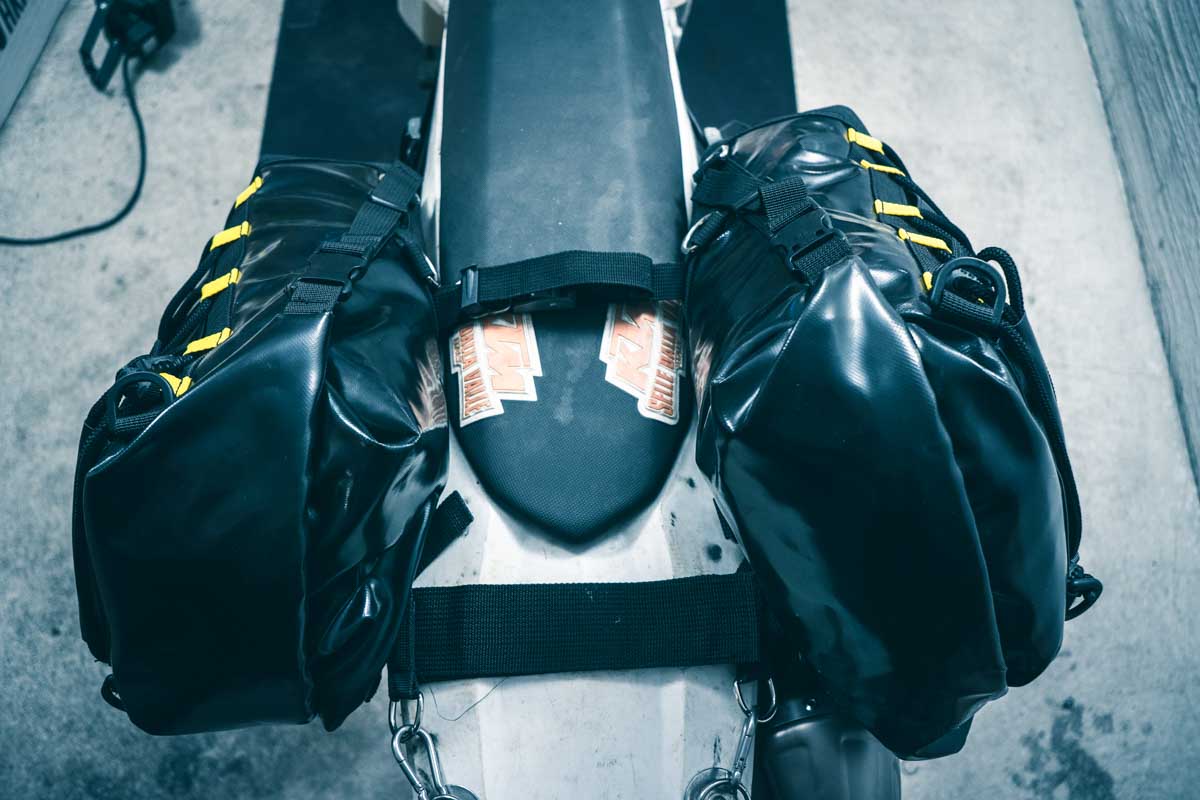
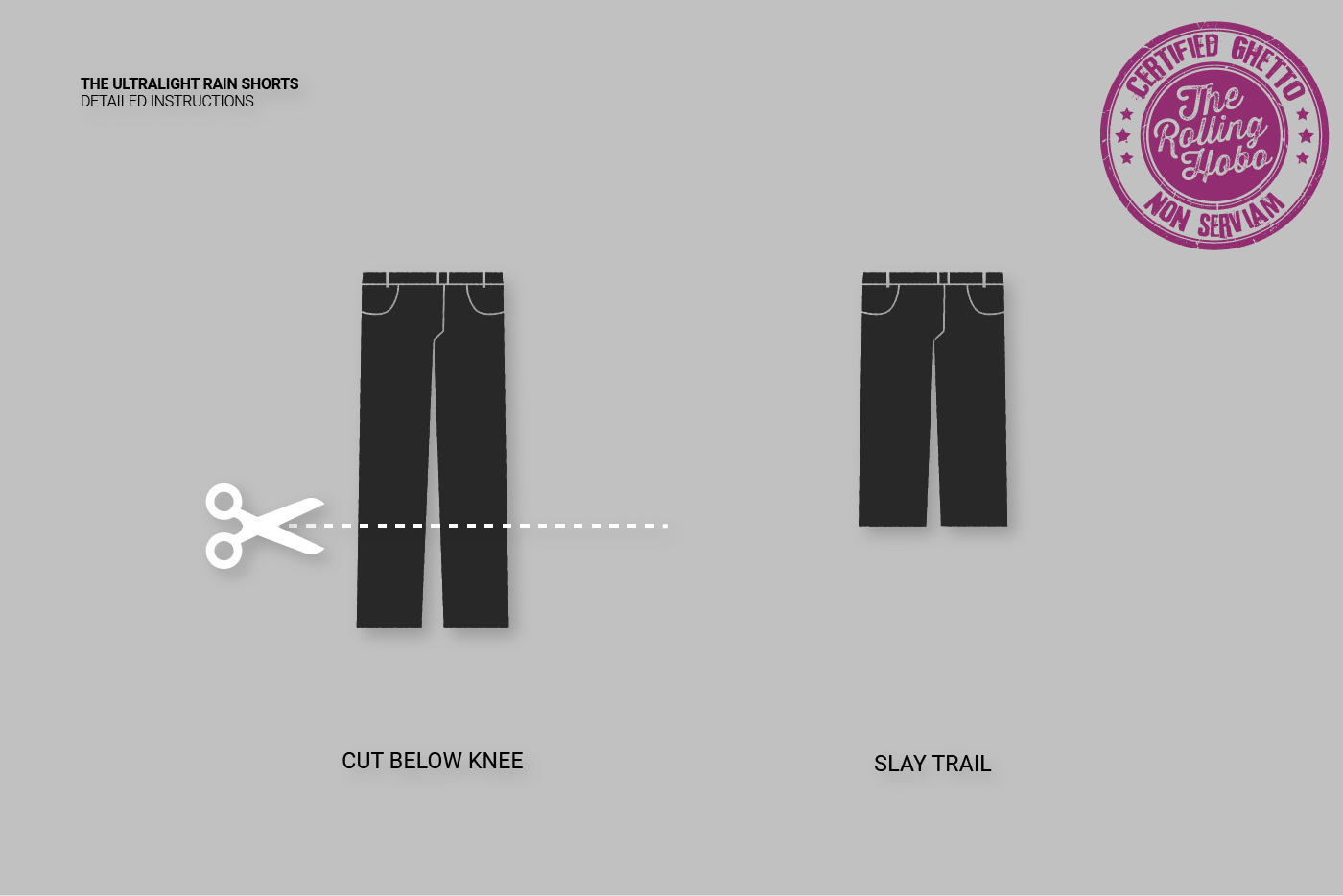
Nice write up, such a huge topic that I could add a lot to if I had the time.
I raced the 950 with mousses, a load more to discuss to make them last. Only use front mousse on my adventure bike for long distance travel and I never use standard mousses, only the rally mousses which are stronger, bigger, have more effective pressure and last longer.
There’s a video on YouTube where I talk about it.
A little tip for you, if you drill and tap your rims in a couple of places and add grease nipples, you can just put a bit more grease in now and again without having to remove, it’ll work it’s way around especially if you don’t use rim locks (which I don’t) with the bigger mousses and it also helps them to last longer.
Installation of a mousse is key also, again, there’s a video I posted up somewhere in the internet holdings
Fun fun.
Hi Lyndon and thanks for sharing your extensive experience. The grease nipple idea sounds like pretty convenient solution as opposed to popping off the mousses for lubing somewhere in the backwoods.
I was originally looking for rally mousses but they seemed rather hard to come by, so went with enduro. Having said that, I do like the traction of the enduro mousse on the 500, but as said, have no experience with rally mousses. Anyhow, would be interesting to hear your views on making them last longer.
Nunca utilicé mousses de enduro, siempre de rally. No practico enduro. Solo Hard trips.
En la 690 los mousses delanteros me llegaron a durar nos 12.000 km. El trasero un poco menos 8.000/10.000. Incluido muchos kilómetros por asfalto,. eso si, sin pasar de 100 km/h. De todas formas, si llevas mucho taco en la rueda, no es nada bueno tampoco pasar de esas velocidades. Aunque lleves cámara. Los tacos duran mucho menos.
Mis consejos para que los mousses duren más son:
– Cuidado al montarlos. Intentar no cortarlos.
– Engrasarlos mucho y bien.
– No elevar la velocidad en asfalto a más de 100 km/h.
– Tener cuidado con el calor.
– Engrasar de vez en cuando.
– Siempre que haya posibilidad, ,mantener la moto elevada. Con las dos ruedas sin tocar el suelo. Sobre todo, si la moto va a estar tiempo parada.
– Yo tampoco utilizo cerraduras de llanta.
– …
Un saludo.
Hola Txague! Muchas gracias por compartir tu experiencia. Estoy muy contento con las mousses, y las usaré este verano también.
Un saludo.
Hi Lyndon and @rollinghobo
I am doing a 10 DAY Tour of Iceland next year and have bought a KTM 690 enduro r. I am being told that using a mousse is not advisable because of the extra weight of saddle bags and frame for tent, cooking and clothes etc. Having read your blog and comments and having used mousses for years without problem on 250-350 trail bikes I am tending to disagree with this advise and may be that it is cautious. I wondered what you thoughts might be? It is not technical but long sections of fire roads and reasonable speed I am told.
Thanks in advance and for such a useful article.
Danny G
Hi Daniel. TBH I have no idea on the longevity of mousses on heavier bikes, but I think Lyndon is the authority on this. You might want to shoot him an email and ask him directly if the doesn’t chime in here? For what it’s worth IMHO weight equals more pressure on the compression point which results in more friction and more heat. The thermal load can be reduced by diligent lubrication and riding slower on the fast sections. My 500 is around 129 kg fully fueled with luggage, and I’m around 100kg in gear. So the total load on the tyres is 230 kg give or take. How much do you reckon the weight on the tyres on your 690 would be in full trim?
Thanks for taking time to respond. I think I will be circa 250kg with me on board. Normal mousses may not be solution however I did see that Technomousse do a Sahara long distance mousse so intend to trial that for a few months on and offroad before going so far as Iceland.
Thanks again for the kind response.
Ok, so the difference in weight is less than 10%. I don’t think there should be a huge difference in the thermal load from weight, but speed is the key.
I’ve been really happy with the Metzeler enduro mousse and the Six Days Extreme tyres. Please let me know how it goes with whatever set up you go with. Will be interesting…
Llevo más de 6 años utilizando mousses en dos 690 y, ahora, en una 501. A todo las personas que me preguntan le explico lo mismo que has escrito en este artículo.
A partir de ahora no tendré que explicárselo, les remitiré el enlace de tu artículo.
Gracias Txague, me alegro de que esto te sea útil. ¡Buena suerte!
Hey mate, how are you?
I have the same opinion like Lyndon. I used the MICHELIN Rally Mousses for 2 years riding some Rallyes.
It´s true the Michelin Rally Mousse is very hard to install in some tyres and you need to be careful to don´t damage the mousse in that process using the Rabaconda or not, but for example i used just one pair of Michelin Rally Mousses in 7 days of Rally in Greece (Hellas Rally 2018) and i didn´t have any problem with the mousses. (i am not a fast rider hahahaa). I consider the MICHELIN Rally Mousse is very good to travel like you explain in your article.
But is true too I feel fear to find some of the mousses disintegrated in the middle of nowhere. Now i am riding a bigger cow with Tubeless Tyres hahahaaaa
Glad to can read you again.
Take care, ride safe and far.
Kind regards fro Switzerland.
LULO
Hey LULO, how are you? All good here, and thanks for contributing to the article. I will look further into the rally mousses for next summer’s rides. TBH I found the Metzeler combo very nice due to the large footprint and the mousse was a bit firmer than the Michelin, although still plenty of traction for slippery enduro.
Be well!
Great explanation with pro and cons! This is what I was waiting for. Thanks a lot for sharing!
Great information from many experienced riders like yourself. Mousse work for the proper application and with minor maintenance. I will stick with tubliss on my “light” adv 701. It is a bigger bike and a bit heavier when loaded. Plus many of my rides have stretches of tarmac where the speed and weight would destroy a mousse.I have not experienced an bladder tube puncture or failure yet in the tubliss system after years of riding trail and adv on them. I have plugged them and back on the trail within minutes where I am waiting for other riders to fix a flat with a tube or patch. I do get frustrated with the bleed down of my tires from time to time and having to air them up every couple of days. I am going to have Woody’s build a set of proper tubless wheels this winter for me. Your blog is inspirational and was the basis for us building up a 500 for ADV use also that my wife loves. Great idea from Lyndon with the grease nipples!
Wow, best information i found so far about using mouse on moto tours. I heard many rumors and Lyndon was the only reliable experience so far. Like Greg i decided for Tubeliss on my 701 for my Africa Trip this year. Main reason is like in his case the abilitiy to increase airpresure for longer asphalt transits. It’s honestly his fault 🙂 Anyways i don’t want to get stuck with that system, because there are ways to break it, thats why i still carry tubes and tools. In future trips in Europe using mousse is definitly on the bucket list mostly to get rid of the tubes and tire tools. Maybe even on a lighter Bike for a 13 Month Moto travel i was simply not brave enough to use an EXC or a FE. The 701 has nearly 50.000km now and 20.000km more will follow, still happy with my choice for that purpose.
Hi Michael! Thanks for your input, I’m glad to hear it’s working for you. I did try to like it, but couldn’t convince myself to committing to it due to the same reasons you mentioned.
Hello Jussi, can’t say it worked for me yet. Right now I can sumarize the roadtransfer to Athens with about 1700km and a short rideout into the trails with Greek friends. During the roadtransfer i lost siginficant amounts of Air already and during the rideout nearly the complete pressure twice in a single day. I checked the highpressure circuit yesterday and it lost air as well. I filled both up again and also filled in some tire sealant. If this doesn’t help the Tubliss Experiment will most likely end already in Egypt and i go back to tubes. I have to admit that my rims are wider than nuetech recommends and i use Motoz tires which are also not recommended. If I had known about all that compatibility issues that a friend told me now earlier i would not have tried it. Impressiv is the fact that you still can ride safely (especially offroad) even without airpressure as long the highpressure circuit is ok.
Hi Michael, For me the extra fail points were the turn off for that system. Anyhow, I hope it works out for you.
@Michael. I have tubliss in both my ktm 450 and 701 (both bikes have the 2,5 inch rear rims) and I run Motoz hybrid and Enduro tires. Never had a problem (10K or more). However, I use it with soapy water and lots of it. Once every 6 months I pour some more soapy water in it via the airvalve. Also installation is critical.
But now just for the hell of it I installed mousses on the 450. Due to lock down I didn’t ride with them yet.
Cheers, love the info on this website
@david lemereis i know about the critical installation process and was already worried while i let the mechanic do it, I should have done it myself so having problems wasn’t such a huge surprise. Anyways the sealant which i filled in in Athens solved my issues. The whole time in Egypt which were about 4000km on different surfaces i haven’t lost any air. Unfortunatly the experiment was put on hold by the pandemic. Hopefully i can continue in autumn.
@Jussi, with a light setup like yours I wouldn’t thing about anything else than mousses. These few times were you ride faster than 100km/h on a highway are not a relevant topic to me at all. According to Lyndon i could run just a combined setup with mousse front and tubes or tubliss in the rear on my heavily loaded 701. From my experience you get pinch flats in front and catch nails in rear so with tubliss on both wheels i get the better overall compromise. Especially in Africa i would carry spare inner tubes anyway no matter which system i run.
I am a new 60-year old rider on a Honda CRF250L. I have Kenda 270 tires and ride 50/50 road mostly to get to state forest gravel/dirt roads. In other words, I don’t need a lot of performance ability and am simply trying to avoid flats. Based on my use of the bike (easygoing touring) and awareness to keep road distances short (less than 100 miles at a time) and speeds reasonable (under 60 mph), do you think a Michelin or a Nitro Mousse is a good option? Again, it’s all about avoiding flats given some of my other limitations. Thank you in advance for any advice.
Hi Shiffy, I don’t see why mousses would not work for you as long as you keep them well lubed. I have no experience on Nitro mousses, so might be a good idea to have a chat with the lads at your local bike shop for more information. Either way, keep rolling!
I started to use a M15 michelin bibmousse in the front tire (michelin tracker 80/100 21) just over a year ago because I ride trails mostly alone and a puncture is always a terrible nuisance in some places. it is now 7000km. those front tires last a long time so I only lubed the mousse once when i changed for a new tire. it´s starting to feel soft but not too soft and the grip is fantastic. the bike is a honda crf450L I use everywhere, mainly to ride trails but also go to work run errands etc. and the bike always handles nicely without too much empty tire feeling and never got dents on the rim yet. when i saw your text it made me very happy to know i could get more 3000km
Hi, what an informative and enjoyable platform you have build. As a new owner of a KTM 500 (came from a Tenere 700) this is true gold. Thank you! I have considered going mousse for the same reasons you point out. But read so much about the backsides that I am looking more towards Tubliss as a solution. Have you had that in consideration? And if so, why not instead of mousse?
Well you can go tubeless, at least for rear for sure. I did went this route (with marine silicone, plenty of videos on utube). It has its drawbacks for sure, like my tyre sealed only at high pressure like 2,5bar. But maybe if I used some tyre sealant it would be fine even with low pressure or rim lock at that precise spot where it doesn’t seal well. Wheels are also quite old and damaged so that is a factor too (and tyre – mine is motoz tract adventure). I have kinda heavy adv bike so no point in going low most of the times, as situations that would require low pressure like deep sand or lots of mud I tend to avoid anyways due to fear of dropping the mastodont. But going low is possibility at least for some time (with a pump of course). But hard to go back – did many miles on the rear (like 14000kms asphalt, 2000kms offroad). The bike was also parked abroad for a whole year and the pressure didn’t drop a one bit. For front I use a tube – it’s a hassle but much easier to fix than rear. You could theoretically go front tubeless as well, if the rim allows it. Mine doesn’t sadly. There has to be a lip on the rim to hold the bead (kinda). Many front tubed rims don’t have that. My bike doesn’t even has it on the rear wheel and it worked flawlessly so far (fingers crossed). Losing pressure in rear is much more easier to control than front, so it’s a safety thing mostly. If you know you are going slow (no highways like me), only offroad or slow twisty roads, I would give it a try even in front. Just don’t go too low with the pressure.